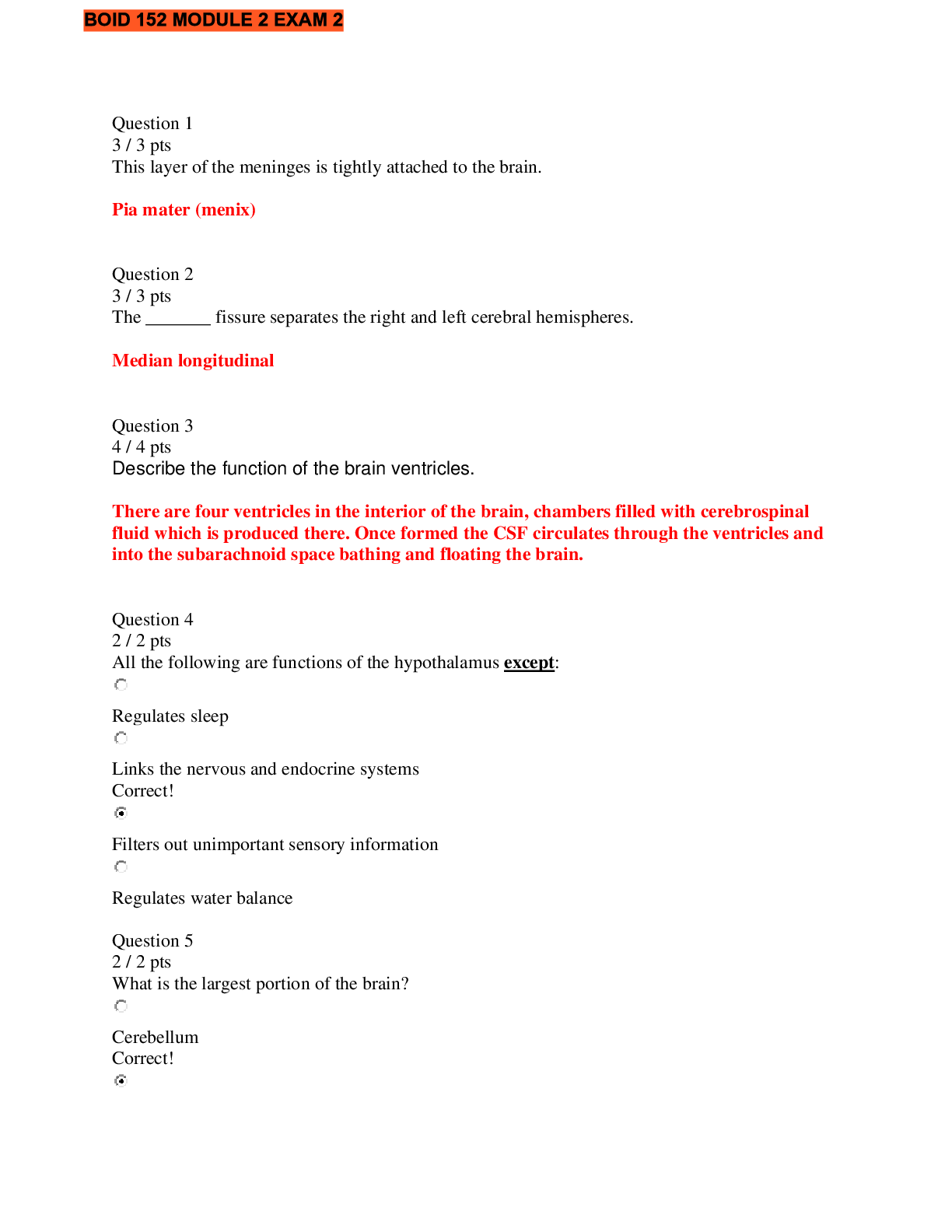*NURSING > QUESTIONS & ANSWERS > Katzung Pharmacology Review 10e 100 Q Exam#2, All Questions with accurate answers, 2022 update, Grad (All)
Katzung Pharmacology Review 10e 100 Q Exam#2, All Questions with accurate answers, 2022 update, Graded A+
Document Content and Description Below
Katzung Pharmacology Review 10e 100 Q Exam#2, All Questions with accurate answers, 2022 update, Graded A+ Question 1: A 52-year-old woman is admitted to the emergency department with a histor... y of drug treatment for several conditions. Her serum electrolytes are found to be as follows (normal values in parentheses): | Na+ 140 mEq/L (135-145) K+ 6.5 mEq/L (3.5-5.0) Cl− 100 mEq/L (98-107) pH 7.3 (7.31-7.41) This patient has probably been taking A Acetazolamide B Atenolol C Digoxin D Furosemide E Spironolactone - ✔✔• spironolactone The correct answer is E. Explanation: This patient is hyperkalemic and slightly acidotic. These changes are typical of a K+-sparing diuretic such as spironolactone. Question 2: Adding a progestin to the estrogenic component of hormone replacement therapy for postmenopausal women provides which of the following effects? A Prevents thromboembolic events B Provides better control of problematic hot flushes C Reduces the risk of endometrial cancer D Restores regular vaginal bleeding E Slows bone loss - ✔✔• progestins The correct answer is C. Explanation: Progestin acts on the endometrium, where estrogen agonists can induce proliferation and endometrial cancer. Progestin has been shown to reduce this risk. Progestin toxicity includes increased blood pressure and a decrease in HDL. Long-term use of progestin can lead to a reduction in bone density. Question 3: A 35-year-old patient is brought to the emergency department in a drug-induced coma. Blood samples taken over the next several hours show a declining drug concentration, as shown in the graph below. Which of the following drugs is the most likely cause of this patient's coma? View Full Size | Save Figure | Download Slide (.ppt) A Aspirin B Diazepam C Ethanol D Phenytoin - ✔✔• diazepam The correct answer is B. Explanation: The graph shows first-order elimination of the drug in question. Aspirin, ethanol, and phenytoin are eliminated mainly by zero-order kinetics. Diazepam is the only drug in the list that is eliminated by first-order kinetics. Question 4: A 42-year-old woman developed a syndrome of polyuria, thirst, and hypernatremia after surgical removal of part of her pituitary gland. These signs and symptoms will be treated with which of the following? A Bromocriptine B Desmopressin C Octreotide D Prednisone E Somatropin - ✔✔• deamino arginine vasopressin The correct answer is B. Explanation: This woman's central diabetes insipidus is due to insufficient posterior pituitary production of vasopressin. Desmopressin, a selective vasopressin V2 receptor agonist, can be administered orally, nasally, or parenterally to treat central diabetes insipidus. Question 5: The mechanism of local anesthetic action of cocaine is A Activation of G protein-linked membrane receptors B Block of the reuptake of norepinephrine at sympathetic nerve endings C Competitive pharmacologic antagonism of nicotinic receptors D Inhibition of blood and tissue enzymes that hydrolyze acetylcholine E Use-dependent blockade of voltage-gated sodium channels - ✔✔• cocaine The correct answer is E. Explanation: Local anesthetics block voltage-dependent sodium channels in excitable tissues including nerves, decreasing action-potential conduction. Rapidly firing fibers are more sensitive than slowly firing nerve fibers. Cocaine has this action and also blocks the reuptake of norepinephrine at sympathetic neuroeffector junctions with effects on both the heart and the CNS. Question 6: Which of the following statements about acyclovir is accurate? A A pro-drug converted to valacyclovir by hepatic enzymes B Active versus cytomegalovirus C Bioactivated by viral thymidine kinase D Highly active against papilloma virus (HPV) E Toxic to bone marrow - ✔✔• acyclovir The correct answer is C. Explanation: Acyclovir is a guanosine analog activated by viral thymidine kinases of HSV and VZV to form acyclovir triphosphate, a competitive substrate for DNA polymerase resulting in chain termination when incorporated into viral DNA. Question 7: Hypercoagulability and dermal vascular necrosis resulting from protein C deficiency is known to be an early-appearing adverse effect of treatment with which of the following drugs? A Alteplase B Aspirin C Clopidogrel D Heparin E Warfarin - ✔✔• warfarin The correct answer is E. Explanation: Warfarin interferes with gamma carboxylation of clotting factors IX, X, VII, and II, and the anticlotting factors protein C and protein S. Alteplase carries the risk of bleeding and not thrombosis. Aspirin can cause gastrointestinal ulcers and bleeding. Heparin is the only drug on this list that can also cause thrombosis, but in the case of heparin, it is mediated not through protein C but rather through an immunologic reaction against heparin-platelet complexes. Question 8: A 15-year-old girl is admitted complaining of palpitations and shortness of breath. An ECG reveals sinus tachycardia with a heart rate of 160 bpm. A drug suitable for producing a brief (5- to 15-min) increase in cardiac vagal effects is A Digoxin B Edrophonium C Ergotamine D Pralidoxime E Pyridostigmine - ✔✔• edrophonium The correct answer is B. Explanation: Symptomatic paroxysmal sinus tachycardia often occurs in young patients and can sometimes be converted to normal sinus rhythm with increased vagal discharge. Brief amplification (5-15 min) of the vagal effects on heart rate can be accomplished with a short-acting cholinesterase inhibitor such as edrophonium. Pyridostigmine (E) would have a much longer action (4-6 hr). Question 9: The long-term daily oral administration of therapeutic doses of prednisone results in which of the following? A Anemia B Decreased bone density C Elevated serum calcium concentration D Hyperplasia of cells in the zona fasciculata and zona reticularis of the adrenal cortex E Increased male-pattern hair growth in women - ✔✔• prednisone The correct answer is B. Explanation: Long-term use of prednisone has several side effects such as growth inhibition, diabetes, muscle wasting, and osteoporosis. Regarding the other options: Excess steroid use results in baldness. Corticosteroids (such as prednisone) can be used to treat some hemolytic anemias. Choice D is incorrect because it describes congenital adrenal hyperplasia, a condition in which the adrenal gland fails to make the hormones cortisol and aldosterone. Treatment would be to provide these hormones to restore physiological levels. Question 10: A 54-year-old farmer has a 5-yr history of frequent, recurrent, and very painful calcium-containing kidney stones. The patient has hypercalciuria caused by a primary defect in proximal tubule calcium reabsorption. Which of the following is the most appropriate chronic therapy for this man? A Aldosterone antagonist B Loop diuretic C NSAID D Strong opioid E Thiazide diuretic - ✔✔• thiazide diuretics The correct answer is E. Explanation: Thiazides increase calcium absorption from the urine into blood, whereas loop diuretics increase calcium excretion from the blood into the urine. None of the other options listed here affects serum calcium. Opioids are indicated for management of severe pain due to kidney stones. Question 11: A 60-year-old man with a history of a mild myocardial infarction was discovered to have low serum HDL cholesterol and moderately high serum triglyceride level. His serum total and LDL cholesterol concentrations were well below the upper limit of normal. Which of the following drugs is likely to result in the greatest lowering of this patient's serum triglyceride concentration and elevation of his serum HDL cholesterol concentration? A Cholestyramine B Ezetimibe C Gemfibrozil D Lovastatin E Rosiglitazone - ✔✔• gemfibrozil The correct answer is C. Explanation: Fibrates are the main triglyceride-lowering drugs. Cholestyramine, ezetimibe, and lovastatin mainly lower LDL cholesterol, whereas rosiglitazone is an antidiabetic drug that increases insulin sensitivity through PPAR-γ activation. Question 12: A 29-year-old accountant has recurrent episodes of tachycardia that sometimes convert to sinus rhythm spontaneously but more often require medical treatment. A drug that is commonly given as an intravenous bolus for the purpose of converting AV nodal tachycardias to normal sinus rhythm is A Adenosine B Amiodarone C Lidocaine D Quinidine E Sotalol - ✔✔• adenosine The correct answer is A. Explanation: Adenosine is favored for the prompt conversion of atrioventricular nodal rhythms to normal sinus rhythm. Adenosine has a very short duration of action (seconds) and good efficacy. Question 13: A 45-year-old woman suffers from abdominal pain and bloody diarrhea that has been diagnosed as Crohn's disease. Which of the following is a first-line drug for treatment of Crohn's disease that acts locally in the gastrointestinal tract to provide an anti-inflammatory effect? A Aluminum hydroxide B Metoclopramide C Misoprostol D Mesalamine E Ranitidine - ✔✔• mesalamine The correct answer is D. Explanation: Mesalamine is a form of 5-aminosalicylic acid (5-ASA) used as first-line treatment for inflammatory bowel disease. Aluminum hydroxide is an antacid used for symptomatic relief of heartburn. Metoclopramide is a prokinetic agent. Misoprostol and ranitidine are used for acid-peptic disease. Question 14: A 40-year-old woman was being treated for chronic moderate hypertension. When she went on vacation and forgot her pills, her blood pressure rose markedly and she was admitted to the emergency service with blurred vision, severe headache, and retinal hemorrhages. A drug that is most likely to be followed by rebound hypertension if stopped suddenly is A Atenolol B Clonidine C Labetalol D Losartan E Prazosin - ✔✔• clonidine The correct answer is B. Explanation: Of the drugs listed, only clonidine, an α2 agonist, is associated with severe rebound hypertension if stopped suddenly. It is speculated that this effect is due to down-regulation of α2 receptors. Question 15: A 24-year-old man with a history of partial seizures has been treated with standard anticonvulsants for several years. He is currently taking valproic acid, which is not fully effective, and his neurologist prescribes another drug approved for adjunctive use in partial seizures. Unfortunately, the patient develops a toxic epidermal necrolysis. The second drug prescribed was A Diazepam B Ethosuximide C Felbamate D Lamotrigine E Phenobarbital - ✔✔• lamotrigine The correct answer is D. Explanation: A number of antiseizure drugs have caused serious toxicities including hepatotoxicity with both valproic acid and felbamate. In the case of lamotrigine, which has been commonly used in the myoclonic seizures, toxic epidermal necrolysis (Stevens-Johnson syndrome) has occurred. Question 16: Propranolol and hydralazine have which of the following effects in common? A Decreased cardiac force B Decreased cardiac output C Decreased mean arterial blood pressure D Increased systemic vascular resistance E Tachycardia - ✔✔• propranolol • hydralazine The correct answer is C. Explanation: Hydralazine reduces blood pressure by direct vasodilation. Propranolol has indirect effects on vascular tone but (at least initially) reduces pressure by reducing cardiac output. Hydralazine thus evokes reflex sympathetic discharge and increases cardiac force, output, and rate. Question 17: A 5-year-old boy was diagnosed as having an intestinal infection with Enterobius vermicularis (pinworm). He should be treated with A Ivermectin B Mebendazole C Mefloquine D Praziquantel E Quinine - ✔✔• mebendazole The correct answer is B. Explanation: Mebendazole is the primary drug for treatment of pinworm, roundworm, and whipworm infections. The drug is contraindicated in pregnancy. Mebendazole and thiabendazole (a more toxic azole) are inhibitors of microtubule synthesis in nematodes. Question 18: Ventricular muscle from a cardiac biopsy was prepared for transmembrane potential recording in an isolated muscle chamber. Action potentials were recorded before and after application of drug X. View Full Size | Save Figure | Download Slide (.ppt) Identify drug X from the following list. A Adenosine B Amiodarone C Procainamide D Sotalol E Verapamil - ✔✔• sotalol The correct answer is D. Explanation: The action potential is prolonged without significant slowing of the upstroke, so the drug effect is mainly on potassium channels (group 3 action) and not on both sodium and potassium channels (group 1a action). Question 19: A patient admitted to the emergency department is vomiting blood. Her supine blood pressure is 100/60 mm Hg; sitting up, her BP is 50/0. Which of the following most accurately describes the probable autonomic response to the bleeding? A Slow heart rate, dilated pupils, damp skin B Rapid heart rate, dilated pupils, damp skin C Slow heart rate, dry skin, increased bowel sounds D Rapid heart rate, dry skin, constricted pupils, increased bowel sounds E Rapid heart rate, constricted pupils, warm skin - ✔✔• autonomic nervous system The correct answer is B. Explanation: Questions about the baroreceptor reflex are common; Figure 6-4 is very high yield. The major responses to hypotension are sympathetic discharge (choice B) and activation of the renin-angiotensin-aldosterone system. FIGURE 6-4 View Full Size | Save Figure | Download Slide (.ppt) Autonomic and hormonal control of cardiovascular function. Note that 2 feedback loops are present: the autonomic nervous system loop and the hormonal loop. Each major loop has several components. In the neuronal loop, sensory input to the vasomotor center is via afferent fibers in the ninth and tenth cranial (PANS) nerves. On the efferent side, the sympathetic nervous system directly influences 4 major variables: peripheral vascular resistance, heart rate, contractile force, and venous tone. The parasympathetic nervous system directly influences heart rate. In addition, angiotensin II directly increases peripheral vascular resistance (not shown), and sympathetic nervous system discharge directly increases renin secretion (not shown). Because these control mechanisms have evolved to maintain normal blood pressure, the net feedback effect of each loop is negative; feedback tends to compensate for the change in arterial blood pressure that evoked the response. Thus, decreased blood pressure due to blood loss would be compensated by increased sympathetic outflow and renin release. Conversely, elevated pressure due to the administration of a vasoconstrictor drug would cause reduced sympathetic outflow, decreased renin release, and increased parasympathetic (vagal) outflow. (Modified and reproduced, with permission, from Katzung BG, editor: Basic & Clinical Pharmacology, 12th ed. McGraw-Hill, 2012: Fig. 6-7.) Question 20: A 30-year-old male patient who is HIV positive has a CD4 T lymphocyte count of 450 cells/μL (normal, 600-1500 cells/μL) and a viral RNA load of 11,000 copies/mL. His treatment involves a 3-drug antiviral regimen (HAART) consisting of zidovudine, didanosine, and efavirenz. Efavirenz limits HIV infection by A Binding to the active site of HIV reverse transcriptase B Blocking the binding of HIV virions to the CD4 receptor on T cells C Inhibiting the HIV enzyme that cleaves sialic acid residues from the surface of HIV virions D Inhibiting the HIV protease E Serving as an allosteric inhibitor of HIV reverse transcriptase - ✔✔• efavirenz The correct answer is E. Explanation: Efavirenz is used in highly active antiretroviral therapy (HAART) regimens against HIV. The drug is an allosteric inhibitor of HIV reverse transcriptase and does not bind to the active site of the enzyme. Question 21: A patient with a 30-yr history of type 1 diabetes comes to you with a complaint of bloating and sour belching after meals. On several occasions, vomiting has occurred after a meal. Evaluation reveals delayed emptying of the stomach, and you diagnose diabetic gastroparesis. Which drug would be most useful in this patient? A Famotidine B Metoclopramide C Misoprostol D Omeprazole E Ondansetron - ✔✔• metoclopramide The correct answer is B. Explanation: Metoclopramide, a dopamine D2 receptor antagonist, is a prokinetic drug that can be used to increase gastric emptying and intestinal motility in patients with diabetes-associated gastric paresis. Famotidine is a histamine H2 receptor antagonist used for acid-peptic disease. Misoprostol is a prostaglandin E1 analog used for acid-peptic disease and for medical abortions. Omeprazole is a proton pump inhibitor used for acid-peptic disease, and ondansetron is a serotonin 5-HT3 receptor antagonist used as an antiemetic. Question 22: A 73-year-old patient has chronic pulmonary dysfunction requiring daily hospital visits for respiratory therapy. She is hospitalized with pneumonia, and it is not clear whether the infection is community or hospital acquired. If she has a community-acquired pneumonia, coverage must be provided for pneumococci and atypical pathogens. In such a case, the most appropriate drug treatment in this patient is A Ampicillin plus gentamycin B Ceftriaxone plus erythromycin C Penicillin G plus gentamicin D Ticarcillin-clavulanic acid E Trimethoprim-sulfamethoxazole - ✔✔• community acquired pneumonia The correct answer is B. Explanation: In a community-acquired pneumonia, the wider spectrum cephalosporin ceftriaxone would cover typical organisms, and erythromycin would be active against the atypical organisms. Question 23: A 48-year-old surgical patient was anesthetized with an intravenous bolus dose of propofol, then maintained on isoflurane with vecuronium as the skeletal muscle relaxant. At the end of the surgical procedure, she was given pyridostigmine and glycopyrrolate. The rationale for use of glycopyrrolate was to A Antagonize the skeletal muscle relaxation caused by vecuronium B Counter emetic effects of the inhaled anesthetic C Counter the potential cardiac effects of the acetylcholinesterase inhibitor D Prevent muscle fasciculations E Provide postoperative analgesia - ✔✔• glycopyrrolate The correct answer is C. Explanation: The acetylcholinesterase inhibitor pyridostigmine can reverse skeletal muscle relaxation (caused by vecuronium) but may also cause bradycardia. The later effect can be prevented by use of glycopyrrolate, which has muscarinic receptor blocking action. Question 24: Ms. B, a 40-year-old woman, has been receiving a slow IV infusion of phenylephrine. She is currently showing an excessive heart rate effect from this drug. A drug that blocks the heart rate effect of a slow IV infusion of phenylephrine is A Atropine B Echothiophate C Neostigmine D Pilocarpine E Propranolol - ✔✔• atropine The correct answer is A. Explanation: The increase in blood pressure caused by pressor drugs such as phenylephrine evokes a reflex slowing of heart rate that is mediated by the vagus nerve acting on muscarinic receptors in the sinoatrial node. This slowing can be blocked by antimuscarinic agents such as atropine. Question 25: A 16-year-old student has had asthma for 8 yr. The number of episodes of severe bronchospasm has increased recently, and you have been asked to review the therapeutic plan. Which of the following agents is most likely to be of immediate therapeutic value in relieving an acute bronchospastic attack? A Albuterol B Atenolol C Formoterol D Metoprolol E Theophylline - ✔✔• albuterol The correct answer is A. Explanation: Albuterol, metaproterenol, and terbutaline are rapid-onset, selective β2 agonists used as first-line therapy for acute asthma. Question 26: A 16-year-old student has had asthma for 8 yr. The number of episodes of severe bronchospasm has increased recently, and you have been asked to review the therapeutic plan. A long-acting β2-selective agonist that is used as an inhaled therapy for moderate or severe asthma is A Ipratropium B Montelukast C Salmeterol D Theophylline E Zafirlukast - ✔✔• salmeterol The correct answer is C. Explanation: Salmeterol and formoterol are slow-onset, long-acting, selective β2 agonists usually used by inhalation with corticosteroids in asthma prophylaxis. Indacaterol is similar but approved only for COPD. Question 27: [Show More]
Last updated: 1 year ago
Preview 1 out of 69 pages
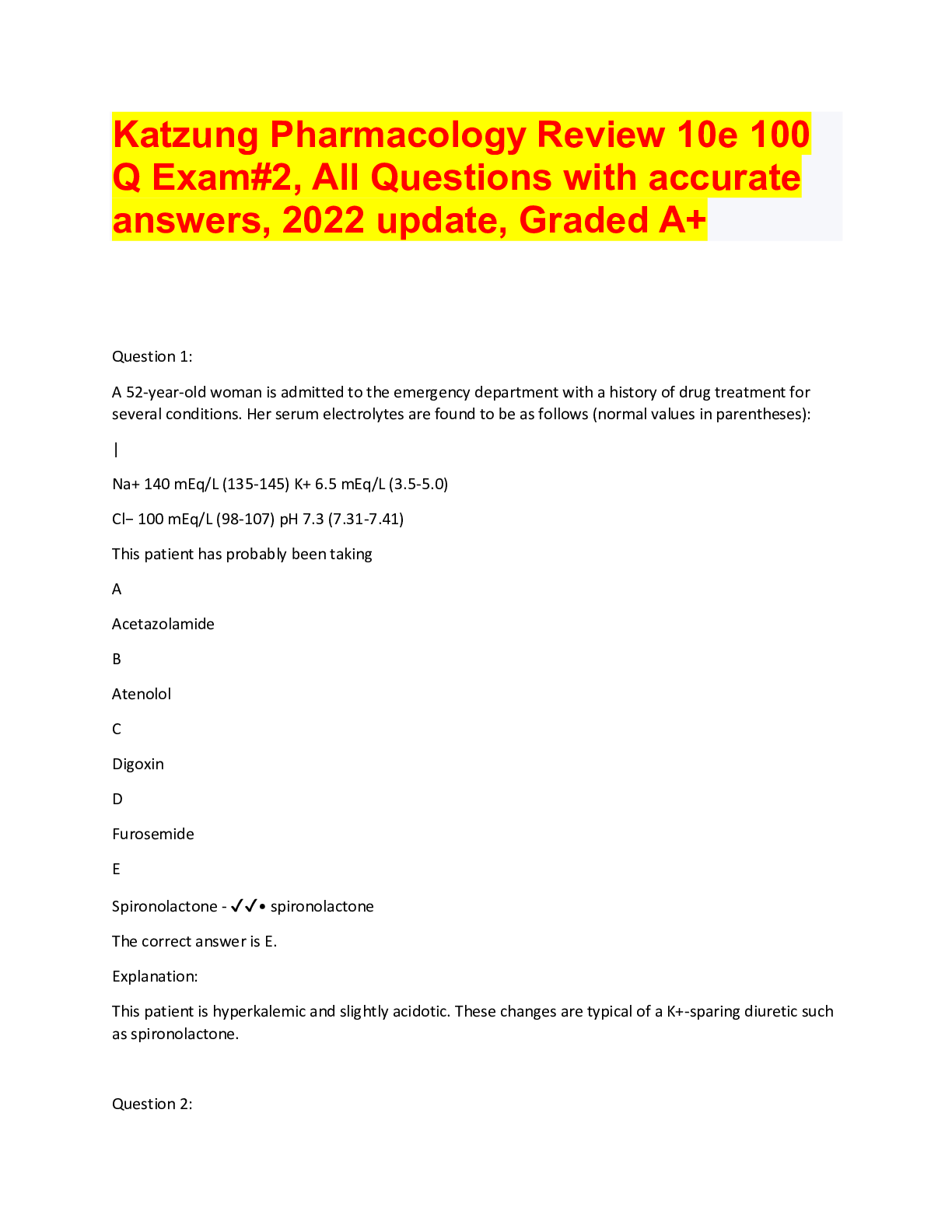
Buy this document to get the full access instantly
Instant Download Access after purchase
Add to cartInstant download
We Accept:

Reviews( 0 )
$12.00
Document information
Connected school, study & course
About the document
Uploaded On
Aug 20, 2022
Number of pages
69
Written in
Additional information
This document has been written for:
Uploaded
Aug 20, 2022
Downloads
0
Views
103












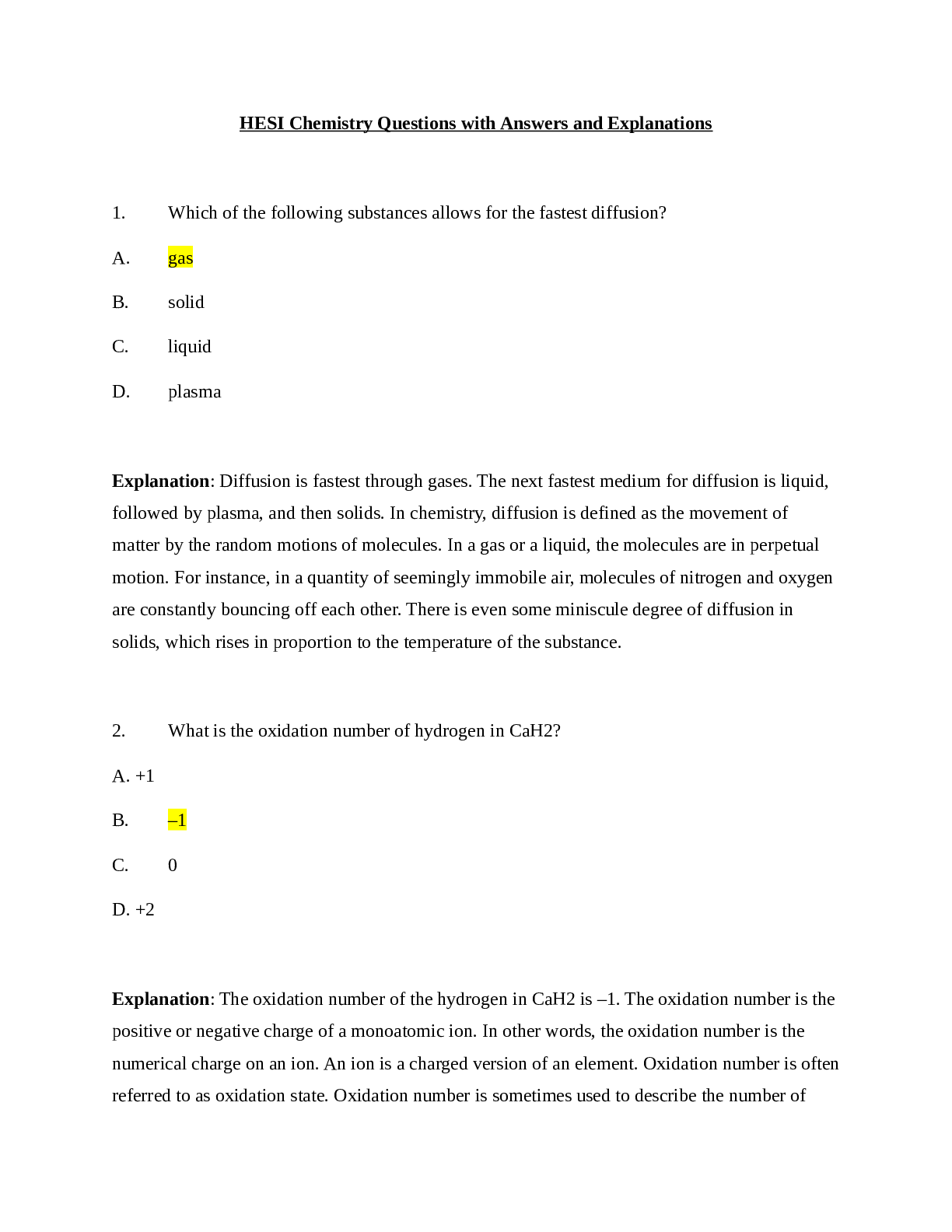

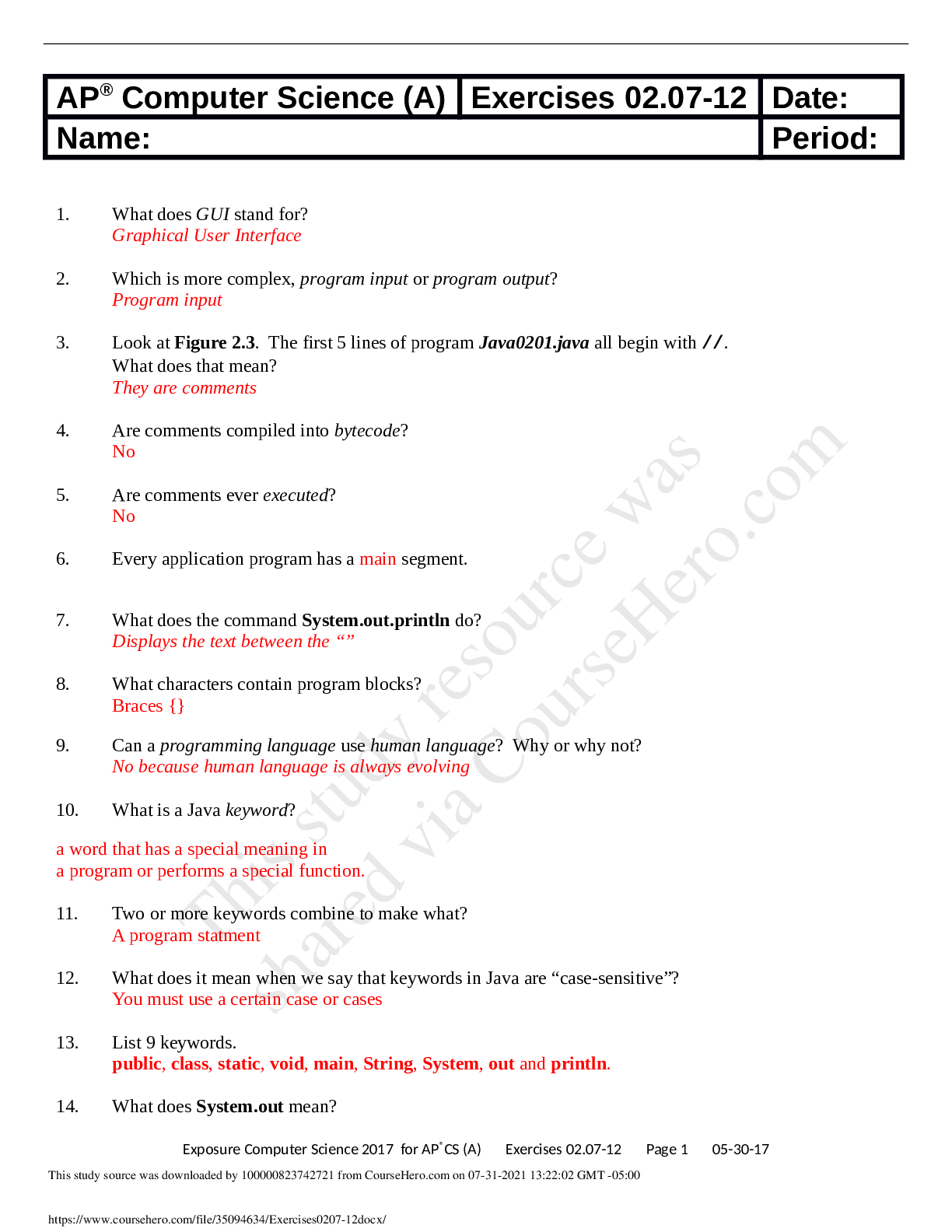
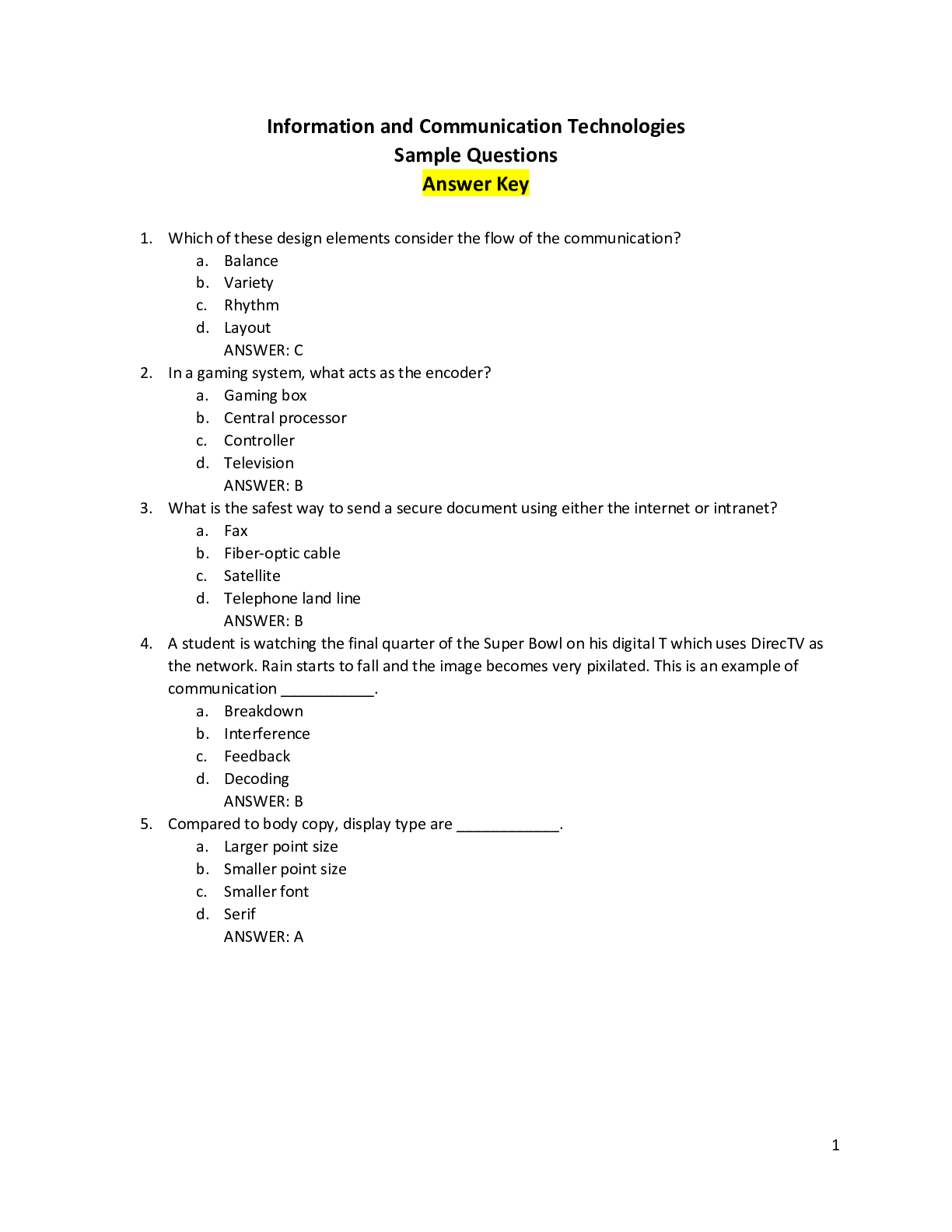
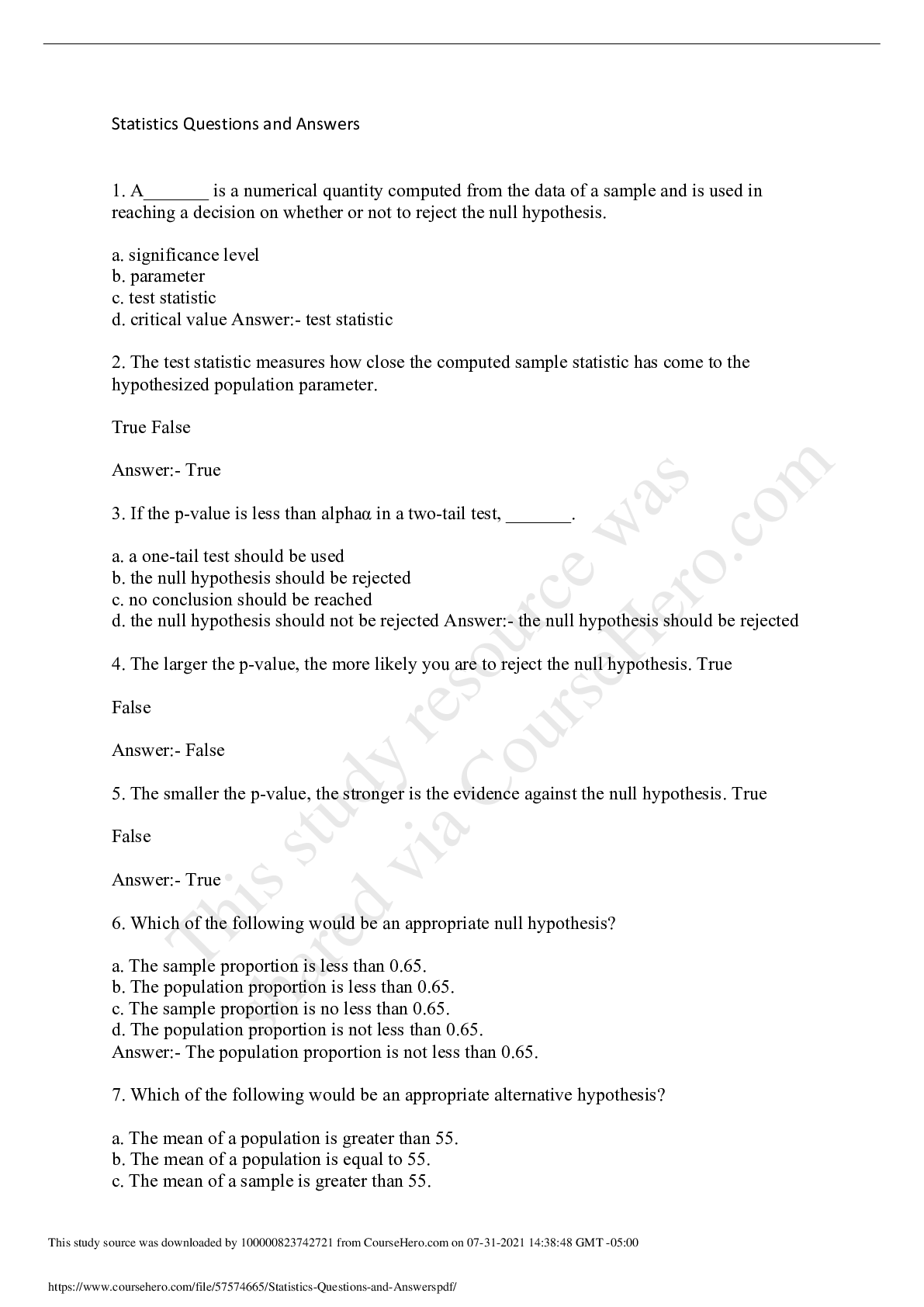
.png)

.png)

